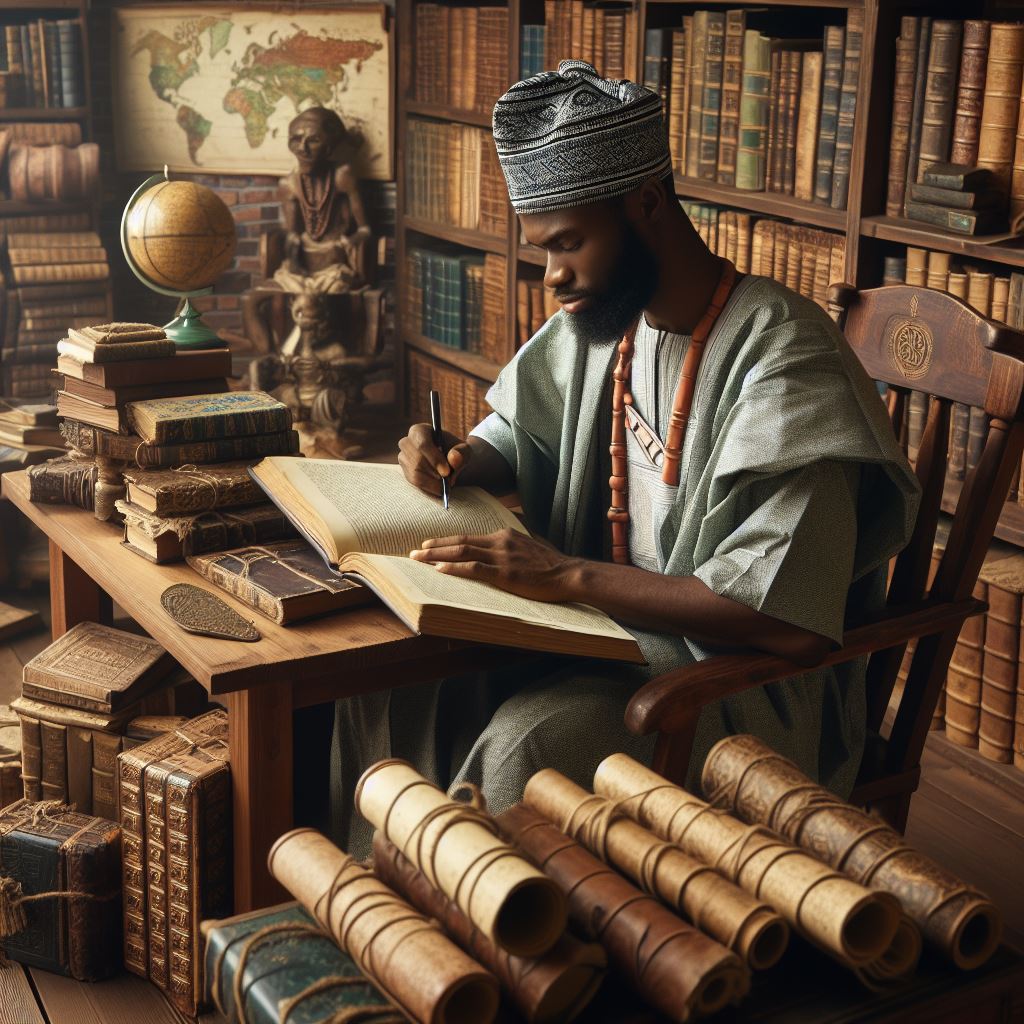Introduction
Arts and crafts in African and Asian Studies encompass a vast spectrum of creative expressions, ranging from traditional handicrafts to contemporary artworks.
These regions boast diverse and vibrant artistic traditions, reflecting their rich cultural heritage and unique socio-historical contexts.
Studying arts and crafts within these cultural contexts is of paramount importance for several reasons.
Firstly, it provides invaluable insights into the cultural values, beliefs, and practices of diverse societies.
Through the lens of arts and crafts, researchers can explore themes such as spirituality, identity, social hierarchies, and gender roles, gaining a deeper understanding of the complexities of these cultures.
Furthermore, arts and crafts serve as powerful vehicles for cultural preservation and transmission.
They embody the collective memory, history, and traditions of communities, serving as tangible artifacts of their heritage.
By studying these artistic traditions, scholars can contribute to the documentation and safeguarding of intangible cultural heritage, ensuring that these traditions are passed down to future generations.
Moreover, arts and crafts play a significant role in fostering social cohesion and community empowerment.
They provide avenues for self-expression, creativity, and cultural exchange, fostering a sense of belonging and pride among individuals and groups.
Additionally, the economic value of arts and crafts cannot be understated, as they often contribute to livelihoods and sustainable development within communities.
Historical background of arts and crafts in Africa
The history of arts and crafts in Africa dates back thousands of years, with evidence of intricate pottery, sculptures, and textiles found in archaeological sites across the continent.
Ancient African civilizations such as the Kingdom of Kush, the Mali Empire, and the Benin Kingdom were known for their highly skilled artisans and craftsmen who created beautiful works of art that reflected their cultural beliefs and traditions.
Trade routes like the Trans-Saharan trade and the Indian Ocean trade helped spread African art forms to other parts of the world, influencing artistic styles in Asia and Europe.
The rich traditions and history of arts and crafts in African cultures
African arts and crafts are deeply rooted in cultural and spiritual beliefs, with each piece telling a story or conveying a message that is often passed down through generations.
Traditional African art forms include beadwork, weaving, wood carving, mask-making, and metalwork, each reflecting the diverse cultural practices and aesthetics of different ethnic groups.
Artisans in Africa often use natural materials like wood, clay, beads, and textiles to create their artworks, showcasing a deep connection to the environment and the land.
These traditions have evolved over time
While traditional African arts and crafts continue to play a significant role in cultural expression and identity, contemporary artists are also incorporating modern techniques and materials into their work.
Globalization and urbanization have brought new influences and opportunities for African artists to experiment with new forms of expression, leading to a fusion of traditional and contemporary styles.
Artists and craftsmen in Africa are using their creativity and skills to address modern issues such as social injustice, environmental sustainability, and cultural preservation, pushing the boundaries of what African art can be.
Read: Famous Nigerian Alumni of Communication Arts Programs
Cultural significance of arts and crafts in Asia
The Role of Arts and Crafts in Asian Societies
Arts and crafts play a significant role in Asian societies, serving as vital expressions of cultural identity.
From intricate pottery in Japan to vibrant textiles in India, each region boasts its unique artistic traditions.
These traditions not only reflect the aesthetic preferences of their creators but also serve as tangible manifestations of cultural heritage.
Artisans in Asia often draw inspiration from their surroundings, incorporating elements of nature, mythology, and spirituality into their creations.
For example, in countries like China and Thailand, traditional crafts such as ceramics and woodcarving are imbued with symbolic meanings derived from ancient belief systems.
These artworks serve not only as decorative pieces but also as conduits for spiritual expression and cultural continuity.
Arts and Crafts are Intertwined with Cultural Beliefs and Practices in Asia
Arts and crafts are deeply intertwined with cultural beliefs and practices in Asia.
For instance, in India, intricate mehndi designs are an integral part of weddings and other festive occasions, symbolizing prosperity and good fortune.
Similarly, in countries like Indonesia and Malaysia, batik textiles are adorned with motifs inspired by local folklore and religious symbolism, reflecting the cultural diversity and spiritual richness of these societies.
Moreover, many Asian cultures place a strong emphasis on the artisanal process itself, viewing craftsmanship as a form of spiritual practice.
In countries such as Japan, the concept of “wabi-sabi” celebrates the beauty of imperfection and impermanence, encouraging artisans to embrace natural materials and simple forms in their creations.
This philosophy not only informs the aesthetic principles of traditional Japanese arts but also reflects deeper cultural values of humility, mindfulness, and appreciation for the fleeting beauty of life.
Generally, arts and crafts are integral to the cultural fabric of Asian societies, embodying centuries of tradition, creativity, and spiritual significance.
By studying these artistic traditions, we gain a deeper understanding of the diverse cultural landscapes of Asia and the profound ways in which creativity intersects with spirituality, mythology, and everyday life.
Read: Digital Media Trends in Communication Arts
Comparison of Artistic Styles Between Africa and Asia
When it comes to artistic styles, Africa and Asia showcase unique and distinct characteristics that set them apart.
In Africa, art is often characterized by bold patterns, intricate designs, and use of vibrant colors to convey deep symbolism and meaning.
Traditional African art includes sculptures, masks, paintings, and textiles that reflect the rich cultural heritage of the various ethnic groups across the continent.
These artworks are often inspired by spiritual beliefs, rituals, and daily life, showcasing a deep connection to nature and the spiritual world.
On the other hand, Asian art is known for its delicate and detailed craftsmanship, with a focus on precision and symmetry.
Art forms such as calligraphy, painting, and ceramics in Asia often showcase a harmonious blend of tradition and innovation.
Influenced by religious beliefs such as Buddhism, Hinduism, and Confucianism, Asian art often reflects themes of spirituality, nature, and philosophical concepts.
The Differences and Similarities in Artistic Techniques and Styles in the Two Regions
In terms of techniques, African art tends to prioritize expressive and emotive forms, using materials such as wood, metal, and clay to create powerful and impactful sculptures and masks.
Meanwhile, Asian art emphasizes mastery of brush strokes, ink washes, and intricate patterns to create intricate and detailed artworks such as scrolls and ceramics.
Both regions share a common emphasis on storytelling through art, whether through oral traditions in Africa or written texts in Asia.
However, the visual representation of narratives differs between the two regions, with African art often portraying symbolic figures and abstract forms, while Asian art tends to focus on figurative and nature-inspired motifs.
Additionally, the role of the artist in society differs between Africa and Asia.
In African societies, artists are often revered as spiritual leaders and cultural custodians, responsible for preserving and passing on traditional knowledge and teachings through their art.
In contrast, Asian artists are seen as skilled craftsmen and intellectuals, valued for their technical expertise and ability to innovate within established artistic traditions.
Cultural Influences Shape the Artistic Expression in Africa and Asia
Cultural influences play a significant role in shaping the artistic expression in both Africa and Asia, providing a unique lens through which artists interpret and represent the world around them.
In Africa, cultural practices deeply intertwine with art, influencing materials, techniques, and motifs in artworks.
Art connects with ancestors, spirits, and the natural world, serving as communication and expression of identity.
Similarly, in Asia, cultural traditions and philosophies such as Confucianism, Taoism, and Zen Buddhism inform artistic practices and aesthetics.
Concepts of harmony, balance, and impermanence are reflected in Asian art forms, emphasizing the interconnectedness of humanity and nature.
Through art, Africa and Asia preserve and celebrate their rich cultural heritage, passing down traditions for generations.
Exploring artistic styles and techniques in these regions deepens our appreciation for global artistic diversity and complexity.
While Africa and Asia differ in art styles, both cherish tradition, spirituality, and cultural heritage in their practices.
Examining how cultural influences shape art in Africa and Asia enhances our understanding of artistic expression.
Read: Communication Arts: Job Prospects and Salaries

Gain More Insights: Impact of Nigerian Arts on African Cinema
You Might Also Like: Understanding the Basics of Economics in Nigeria
Impact of globalization on arts and crafts in Africa and Asia
Globalization Has Affected the Production and Consumption of Arts and Crafts in These Regions
Globalization has transformed the landscape of arts and crafts production and consumption in Africa and Asia.
Globalization’s interconnectedness fosters the exchange of ideas, techniques, and materials across borders. It enriches artistic practices with diverse influences.
As artisans access global markets via digital platforms, traditional barriers to entry diminish gradually.
However, the influx of mass-produced goods and cheap imports poses a significant challenge to artisans in these regions.
Traditional craftsmanship faces the threat of being overshadowed by standardized products flooding the market.
Moreover, the commodification of cultural artifacts for tourist consumption can lead to the dilution of authenticity and cultural significance.
The Challenges and Opportunities for Artists and Craftsmen in Africa and Asia in the Global Market
Amidst these challenges, there are also opportunities for artists and craftsmen to thrive in the global market.
Digital platforms provide a means for artisans to showcase their work to a global audience, bypassing traditional intermediaries.
Collaborations with designers, NGOs, and fair trade organizations offer avenues for artisans. They access new markets while upholding ethical and sustainable practices.
Nevertheless, navigating the complexities of the global market presents its own set of hurdles.
Limited access to technology and financial resources can impede artisans’ ability to leverage digital platforms effectively.
Furthermore, stringent international trade regulations and intellectual property rights pose barriers to entry. These challenges affect small-scale artisans with limited legal resources.
Moreover, artisans are faced with the challenge of balancing traditional craftsmanship with contemporary market demands.
While innovation is essential for staying relevant, artisans must also preserve the cultural integrity and authenticity of their craft.
Finding this delicate balance requires creativity, adaptability, and a deep understanding of both traditional techniques and modern consumer preferences.
Essentially, globalization has reshaped the landscape of arts and crafts in Africa and Asia. It presents challenges and opportunities for artisans.
While the global market offers unprecedented access to new audiences and resources, artisans must navigate competition, commodification, and cultural preservation.
They ensure the longevity and sustainability of their craft in an increasingly interconnected world.
Read: Internship Opportunities for Communication Arts Students
Uncover the Details: Top Nigerian Fashion Designers You Should Follow
Explore Further: Exchange Programs for Nigerian Chinese Studies Students
Explore Further: How Anthropology Helps Understand Nigerian Ethnic Groups
Contemporary trends in arts and crafts in Africa and Asia
Emerging Artists and Craftsmen Who are Redefining Traditional Art Forms in Africa and Asia
Across Africa and Asia, a new generation of artists and craftsmen is revolutionizing traditional art forms.
These emerging talents are infusing age-old techniques with contemporary aesthetics, breathing new life into cultural heritage.
From intricate beadwork in Kenya to innovative ceramics in Japan, these artists are pushing boundaries and challenging conventions.
In Kenya, artists like Beatrice Wanjiku are transforming traditional beadwork into stunning contemporary sculptures, exploring themes of identity and social commentary.
Similarly, in Japan, ceramicists like Kazuya Kusaka blend traditional pottery techniques with modern design sensibilities.
They create striking pieces bridging the gap between past and present.
Modern Technologies and Changing Societal Values are Influencing Arts and Crafts in These Regions
Modern technologies and shifting societal values are profoundly shaping arts and crafts in Africa and Asia.
The advent of digital tools and platforms has revolutionized the way artisans create, market, and sell their work.
3D printing enables artisans to experiment with new forms and materials. Social media offers a global stage for showcasing their creations.
Furthermore, changing societal values are influencing artistic expression and subject matter.
As societies become more interconnected and diverse, artists are exploring themes of identity, inclusivity, and environmental sustainability in their work.
In India, textile artists incorporate eco-friendly materials and traditional dyeing techniques. They create sustainable fashion resonating with contemporary consumers.
Moreover, there is a growing emphasis on social impact and community engagement within the arts and crafts sector.
Artists and craftsmen are using their platforms to address pressing social issues and advocate for positive change.
These artists promote gender equality and preserve indigenous cultures. They leverage their creativity to make a meaningful societal impact.
Essentially, the intersection of tradition and innovation is at the heart of arts and crafts in Africa and Asia.
Emerging artists and craftsmen redefine traditional art forms. Modern technologies and changing societal values shape the trajectory of artistic expression.
As these regions evolve, the arts and crafts sector will reflect and shape cultural identity and social transformation.
Uncover the Details: Career Paths in History & Strategic Studies in Nigeria
You Might Also Like: Why Study Economics? Insights for Nigerian Students
Conclusion
Lastly, exploring the arts and crafts in African and Asian studies sheds light on unique cultural practices.
These artistic expressions are crucial in preserving the heritage and traditions of these regions.
Studying arts and crafts in African and Asian studies provides valuable insights into the historical, social, and economic contexts of these societies.
It allows for a better understanding of the diverse cultural landscapes that exist in these regions.
Additionally, through the examination of arts and crafts, we can appreciate the creative talents and skills of artisans who contribute to the rich cultural tapestry of Africa and Asia.
This recognition helps in promoting a sense of respect and admiration for these artistic traditions.
Moreover, studying arts and crafts in African and Asian studies serves as a bridge for global understanding and appreciation of diversity.
It fosters intercultural dialogue and promotes mutual respect among different communities worldwide.
Overall, the study of arts and crafts in African and Asian studies is essential for cultural preservation and promoting cross-cultural communication.
It enriches our knowledge of the world and helps us celebrate the beauty and creativity of human expression across continents.




